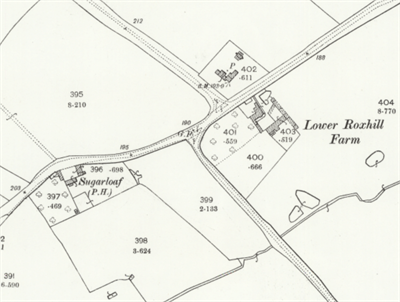Sugar Loaf Public House, Roxhill
Sugar Loaf Public House, Marston Hill, Roxhill, Marston Moretaine

Ordnance Survey Map 2nd edition 1901, showing location of the Sugarloaf PH
The former Sugar Loaf (or Sugarloaf) is listed by Historic England as Grade II (of special interest). The listing describes it as built in the earlier 18th century with a colourwashed rendered infill, a thatched roof, a three-bay plan, one storey and attics. The ground floor has three 3-light casement windows and the attic has one eyebrow dormer window with a 2-light casement. The 20th century gabled porch has a clay tiled roof. There is one red bridge ridge chimney stack and one red brick gable end chimney stack. A 20th century extension projects to the rear.
In 1799 the Sugar Loaf, occupied by Samuel Clare, was sold together with an adjacent five acre field and other property, to brewer Peregrine Nash of Bedford by Marston Moretaine blacksmith John Sheard and his wife Mary. Through Peregrine Nash the Sugarloaf became the property of the Newland and Nash brewery.
The Sugar Loaf is mentioned in a settlement case relating to Elizabeth Line (also known as Wharton), the daughter of a former landlord. When the parish of St. Pancras applied in 1878 to have her removed from its workhouse back to her home parish of Marston Moretaine, evidence was given that her father Thomas Line had been the tenant of the Sugar Loaf at Marston Moretaine for two years from around 1826, and then of the Exhibition Inn, also in Marston at Upper Shelton, from around 1831 for five years, paying £10 rent per annum. Elizabeth Line’s brother-in-law Edward Douglas, said in a statement that Elizabeth had lived with a Mr Robinson at Kensington and had three children by him. About six years ago she had lived with himself and his wife (her older sister), but her habits were “so loose” that they sent her away. They then saw little of her until three years previously, by which time she was an “indoor pauper” (in other words, an inmate of the workhouse). His wife believed that Elizabeth had been born at the Sugar Loaf. She recalled living with her parents at a little public house in Bedford for 2 or 3 years, then they had returned to the Exhibition at Marston, where her father had died and her mother had remarried [reference PUAV41/45].
The Sugar Loaf is mentioned a couple of time in depositions (witness statements) for cases heard at the Quarter Sessions in Bedford. In 1832 Richard Fountain of Cranfield bought a stolen duck while drinking at the Sugar Loaf, and in 1849 two local women were sent by two men to buy beer from the Sugar Loaf with what proved to be counterfeit half-crowns.
In 1867 a fire insurance policy valued the Sugar Loaf at £200, a detached washhouse and stable at £50 and another detached stable and shed at £30.
Under the terms of the Rating and Valuation Act 1925 every piece of land and building in the country was assessed to determine the rates to be paid on them. When Marston Moretaine was assessed in 1927 the Sugar Loaf was owned by Wells and Winch Ltd, who had taken it over from Newland and Nash Ltd, and it was occupied by Charles Lower. The rent was £19 per annum, which included three fields totally about five acres. The public rooms were a tap room and bar and the private rooms a living room, a scullery, a cellar and three bedrooms. Outside were a washhouse, two horseboxes, two fowlhouses and a two bay shed. Sales amounted to about 45 18 gallon barrels a year, with about 5 gallons of spirits; the licensee described trade as “very poor”.
The Sugar Loaf closed in 1959 and the licence was transferred to the Woolpack at Wilstead. The former Sugar Loaf is now a private house.
References:
-
GK137/1-5: Deeds and insurance policy relating to the Sugar Loaf, 1778–1875;
-
GK159/1: Transfer of mortgage 1889
-
GK3/3: Schedule of deeds
-
PUAV41/45: Settlement papers for Elizabeth Wharton (Line), daughter of former landlord Thomas Line, 1878;
-
QSR1833/1/5/5: Depositions in case relating to stolen ducks and drakes, 1832;
-
QSR1949/3/5/18-19/b,c: Depositions relating to counterfeit coin, 1849;
Licensees: note that this is not a complete list and that dates in italics are not necessarily beginning or end dates, merely the first/last date which can be confirmed from sources such as directories and deeds:
1822: Elizabeth Clare
1826-1828: Thomas Line
1841-1871: Robert Foskett
1876-1902: John Brockett
1902-1927: Charles Lowe
1927-1931: George Coomber
1931-1958: James John Pitts
1958-1959: Charles Graham Pressland (closed 1959)